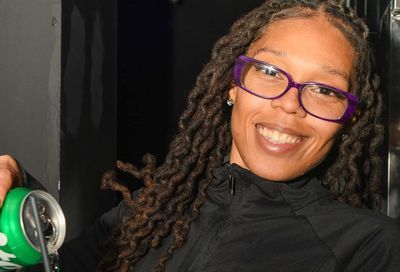AIDS 2025 Highlights Breakthroughs Amid Funding Cuts
Scientific breakthroughs take center stage at the International AIDS Society Conference as global HIV funding and political support erode.

Addressing the opening session of the 25th International AIDS Society Conference, held last month in Kigali, Rwanda, conference co-chair and IAS president Beatriz Grinsztejn set the tone sharply for AIDS 2025.
“We come together at a pivotal time for the HIV response,” Grinsztejn began. “One defined by both incredible scientific possibilities and deeply troubling political realities.”
Among the thousands of researchers, policy makers, healthcare professionals, funders, media, community advocates, and, crucially, people living with HIV, assembled at the event — the world’s largest conference on HIV and AIDS — many brought firsthand experience of the paradox Grinsztejn described.
“On the one hand, science has never been stronger,” she said. “We have the knowledge, the tools, and the innovation to end AIDS as a public health threat. As we stand here today, the evidence of progress is clear.”
Touting not only the dedication and know-how of research and health professionals, but the power of prevention science, with long-acting PrEP and new mRNA-based strategies in cure research, Grinsztejn marked key innovations.
“On the other hand,” she pointed out, “we are witnessing global budget cuts, waning political will, and rising inequality. Our HIV movement — a movement forged in activism, grounded in science, and powered by community — is being severely tested once again.”
Noting the invaluable contributions made over many years by U.S. government agencies like USAID — formerly “the largest implementing partner of PEPFAR,” now shut down due to the Trump administration’s DOGE cuts — Grinsztejn lamented the loss of vital resources on the field of battle. “With its closure, we have lost thousands of committed health development experts.”
Yet, resilience is also key, and proved a persistent theme at the confab, where the official mantra looking towards the future is “rethink, rebuild, and rise.” While the impact of U.S. funding cuts was a leading topic of official talks and informal conversation, there also was the usual buzz of excitement surrounding forward strides and breakthroughs.

The growing toolbox of options for long-acting HIV prevention drove much discussion. In particular, lenacapavir, the twice-yearly injectable for prevention, continued to grab attention.
Data has already shown lenacapavir is almost 100% effective in preventing HIV acquisition among adult men and women. New Phase 3 study data presented at the conference showed that in the first-ever lenacapavir trial to include pregnant and lactating people, historically excluded from PrEP trials, the drug showed high efficacy and safety, with no HIV infections.
The Phase 3 data also demonstrated lenacapavir’s high efficacy and favorable safety among adolescents and young people in the trial, bolstering the drug’s profile as a preferred option. Accordingly, the drug’s maker, Gilead Sciences has partnered with the Global Fund to Fight AIDS, Tuberculosis and Malaria on an access agreement, announced just before the conference.
The Global Fund will procure lenacapavir for low- and middle-income countries (LMICs), marking the first time in history that an HIV prevention product will be introduced in LMICs at the same time as in high-income countries.
Equally exciting, a new prevention tool might soon join lenacapavir inside the global toolbox. Known as MK-8527, this investigational once-monthly oral pill for HIV prevention was tested in a double-blind, multicenter study of adults ages 18-65. Results presented at the conference showed MK-8527 was well-tolerated by participants.
Now, the drug advances to Phase 3 trials, while the rollouts of lenacapavir and long-acting injectable cabotegravir (CAB-LA) continue apace. Though, beyond the expanding reach of pharmaceutical treatment methods, several sessions at AIDS 2025 focused on innovations in technology for delivery of accessible, efficient HIV and other health services.
Unsurprisingly, many such innovations were driven by AI, or the use of AI, as with the chatbot MARVIN, a support tool for people living with HIV who are experiencing stigma and mental health challenges like anxiety and depression.
Created by researchers in Canada who prompt-tuned ChatGPT to classify message intent into three categories — self-harm, insult, or non-extreme (i.e., any other intent) — MARVIN listens for signs of self-harm and suicidal ideation, and generates appropriate responses like emergency contact information, as well as a response reviewed by a medical expert.
Throughout the conference, proof that science and technology can deliver positive results stood alongside testimony about the dire impact of funding cuts to the very programs that produce those results.
Yet, as Grinsztejn asserted, “Science remains the backbone of our response. It always has been, and it must continue to guide our response. It was science that gave us antiretroviral therapy, PrEP, PeP, and U=U.”
Science drives innovation, she said, from long-acting injectables to vaccines and a potential cure. “Following science must remain our guide, free of politics and persuasion.”
AIDS 2026 will be held in Rio de Janeiro, Brazil, and virtually in July 2026. Visit www.iasociety.org.
Support Metro Weekly’s Journalism
These are challenging times for news organizations. And yet it’s crucial we stay active and provide vital resources and information to both our local readers and the world. So won’t you please take a moment and consider supporting Metro Weekly with a membership? For as little as $5 a month, you can help ensure Metro Weekly magazine and MetroWeekly.com remain free, viable resources as we provide the best, most diverse, culturally-resonant LGBTQ coverage in both the D.C. region and around the world. Memberships come with exclusive perks and discounts, your own personal digital delivery of each week’s magazine (and an archive), access to our Member's Lounge when it launches this fall, and exclusive members-only items like Metro Weekly Membership Mugs and Tote Bags! Check out all our membership levels here and please join us today!



























You must be logged in to post a comment.